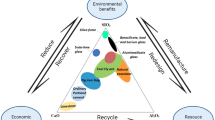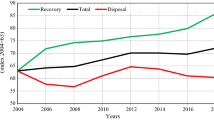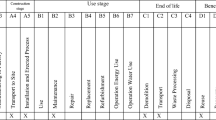Abstract
Recent studies have led to the development of approaches for recycling plastic waste and using it as an alternative for natural aggregates in concrete. The studies mainly focused on the material properties and sustainability aspects of such implementation, with little focus on the financial implications and the technical feasibility. The purpose of this research is to investigate the different lifecycle costs associated with the use of green recycled plastic lightweight aggregates (GLACs) in concrete construction in different structural systems. For that purpose, the authors evaluated a concrete structure with several variable design systems and conducted structural design once using conventional concrete and once using concrete with recycled plastic aggregates, resulting in a total of 36 distinct scenarios. The lifetime cost analysis was performed on such scenarios. Finally, a sensitivity analysis was carried out to determine how structural characteristics and critical element costs influence cost-effectiveness. According to the findings, this approach can save up to 6% in life-cycle expenses. The findings of this research will contribute to the upcoming paradigm shift of using recycled plastic in concrete, which will reduce the environmental impacts of both the concrete and plastic industries while also assisting developers in lowering their life cycle costs.
Similar content being viewed by others
Abbreviations
- GGBFS:
-
Ground granulated blast-furnace slag
- GHG:
-
Greenhouse gas
- GLAC1:
-
Green lightweight aggregate concrete (Type 01)
- GLAC2:
-
Green lightweight aggregate concrete (Type 02)
- IBC:
-
International Building Code
- LCA:
-
Life cycle assessment
- LCC:
-
Life cycle cost
- LCIA:
-
Life cycle impact assessment
- LLDPAE:
-
Linear low-density polyethylene
- NCA:
-
Normal weight aggregate
- NCAC:
-
Normal weight aggregate concrete
- NWC:
-
Normal weight concrete
- PGLA:
-
Plastic-based green lightweight aggregate
- PLA:
-
Plastic lightweight aggregate
- SLWC:
-
Structural light weight concrete
- VLA:
-
Volcanic lightweight aggregate
- VLAC:
-
Volcanic light weight aggregate concrete
References
ACI 211.2-98 (1998) Standard practice for selecting proportions for structural lightweight concrete (Reapproved 2004). American Concrete-ACI Committee 211; American Concrete Institute: Farmington Hills, MI, USA
Akçaözoglu S, Atiş CD, Akçaözo҇lu K (2010) An investigation on the use of shredded waste PET bottles as aggregate in lightweight concrete. Waste Manag 30(2):285–290, DOI: https://doi.org/10.1016/j.wasman.2009.09.033
Akhtar A, Sarmah AK (2018) Construction and demolition waste generation and properties of recycled aggregate concrete. A Global Perspective, J. Clean Prod. 186:262–281
Albano C, Camacho N, Hernández M, Matheus A, Gutiérrez A (2009) Influence of content and particle size of waste pet bottles on concrete behavior at different w/c ratios. Waste Manag 29(10):2707–2716, DOI: https://doi.org/10.1016/j.wasman.2009.05.007
Alqahtani FK (2021) Sustainable green lightweight concrete containing plastic-based green lightweight aggregate. Materials 14:3304, DOI: https://doi.org/10.3390/ma14123304
Alqahtani FK, Abotaleb IS, Harb S (2021) LEED study of green lightweight Aggregates in construction. Sustainability 13(3):1395
Alqahtani FK, Abotaleb Ibrahim S (2022) Life cycle cost analysis of lightweight green concrete utilizing recycled plastic aggregates. Journal of Building Engineering, DOI: https://doi.org/10.1016/j.jobe.2021.102670
Alqahtani FK, Ghataora G, Dirar S, Khan MI, Zafar I (2018) Experimental study to investigate the engineering and durability performance of concrete using synthetic aggregates. Construction and Building Materials 173(10):350–358, DOI: https://doi.org/10.1016/j.conbuildmat.2018.04.018
Alqahtani FK, Ghataora G, Khan MI, Dirar S (2017) Novel lightweight concrete containing manufactured plastic aggregate. Construct. Build. Mater. 148:386–397, DOI: https://doi.org/10.1016/j.conbuildmat.2017.05.011
Alqahtani FK, Zafar I (2020) Characterization of processed lightweight aggregate and its effect on physical properties of concrete. Construction and Building Materials 230:116992, DOI: https://doi.org/10.1016/j.conbuildmat.2019.116992
Asdrubali F, Baldassarri C, Fthenakis V (2013) Life cycle analysis in the construction sector: Guiding the optimization of conventional Italian buildings. Energy and Buildings 64:73–89, DOI: https://doi.org/10.1016/j.enbuild.2013.04.018
ASTM C143/C143M-15 (2015) Standard test method for slump of hydraulic-cement concrete. ASTM International: West Conshohocken, PA, USA
Babu DS, Ganesh Babu K, Wee TH (2005) Properties of lightweight expanded polystyrene aggregate concrete containing fly ash. Cement and Concrete Research 35(6):1218–1223, DOI: https://doi.org/10.1016/j.cemconres.2004.11.015
Batayneh M, Marie I, Asi I (2007) Use of selected waste materials in concrete mixes. Waste Management 27(12):1870–1876, DOI: https://doi.org/10.1016/j.wasman.2006.07.026
Broadbent C (2016) Steel’s recyclability: Demonstrating the benefits of recycling steel to achieve a circular economy. International Journal Life cycle assessment 21(11):1658–1665, DOI: https://doi.org/10.1007/s11367-016-1081-1
Cabeza LF, Rincón L, Vilariño V, Pérez G, Castell A (2014) Life cycle assessment (LCA) and life cycle energy analysis (LCEA) of buildings and the building sector: A review, Renew. Renewable and Sustainable Energy Reviews 29:394–416, DOI: https://doi.org/10.1016/j.rser.2013.08.037
Capital Scrap Metal (CSM) LLC (2017) Price of scrap metal, 2017
Chakraborty D, Elhegazy H, Elzarka H, Gutierrez L (2020) A novel construction cost prediction model using hybrid natural and light gradient boosting. Advanced Engineering Informatics 6, DOI:https://doi.org/10.1016/j.aei.2020.101201
Chakraborty D, Elzarka H, Bhatnagar R (2016) Generation of accurate weather files using a hybrid machine learning methodology for design and analysis of sustainable and resilient buildings. Sustainable Cities and Society 24:33–41
Choi Y-W, Moon D-J, Chung J-S, Cho S-K (2005) Effects of waste PET bottles aggregate on the properties of concrete. Cement and Concrete Research 35:776–781
Choi YW, Moon DJ, Kim YJ, Lachemi M (2009) Characteristics of mortar and concrete containing fine aggregate manufactured from recycled waste polyethylene terephthalate bottles. Construction and Building Materials 23:2829–2835
Colangelo F, Cioffi R (2017) Mechanical properties, and durability of mortar containing fine fraction of demolition wastes produced by selective demolition in South Italy. Composites Part B: Engineering 11543–11550
Colangelo F, Navarro TQ Farina I, Petrillo A (2020) Comparative LCA of concrete with recycled aggregates: A circular economy mindset in Europe. The International Journal of Life Cycle Assessment 25(9):1790–1804
Davidovits J (2017) Geopolymers based on natural and synthetic metakaolin — A critical review. Proceedings of the 41st International Conference on Advanced Ceramics and Composites 201–214
Elhegazy H (2021) State-of-the-art review on benefits of applying value engineering for multi-story buildings. Intelligent Buildings International, DOI: https://doi.org/10.1080/17508975.2020.1806019
Elhegazy H, Badra N, Aboul Haggag S, Abdel Rashid I (2022a) Implementation of the neural networks for improving the project’s performance of steel structures projects. Journal of Industrial Integration and Management, DOI: https://doi.org/10.1142/S2424862221500251
Elhegazy H, Chakraborty D, Elzarka H, Ebid AM, Mahdi IM, Aboul Haggag SY, Abdel Rashid I (2022b) Artificial intelligence for developing accurate preliminary cost estimates for composite flooring systems of multi-storey buildings. Journal of Asian Architecture and Building Engineering 21(1):120–132, DOI: https://doi.org/10.1080/13467581.2020.1838288
Elhegazy H, Ebid A, Mahdi I, Haggag S, Abdul-Rashied I (2021) Implementing QFD in decision making for selecting the optimal structural system for buildings. Construction Innovation 21(2):345–360, DOI: https://doi.org/10.1108/CI-12-2019-0149
Elhegazy H, Ebid AM, Mahdi IM, Aboul Haggag S, Abdel Rashid I (2020) Selecting optimum structural system for R.C. multi-story buildings considering direct cost. Structures 24:296–303, DOI:https://doi.org/10.1016/j.istruc.2020.01.039
Elmousalami HH (2019) Intelligent methodology for project conceptual cost prediction. Heliyon 5(5), DOI: https://doi.org/10.1016/j.heliyon.2019.e01625
Ersan YC, Gulcimen S, Imis TN, Saygin O, Uzal N (2020) Life cycle assessment of lightweight concrete containing recycled plastics and fly ash. European Journal of Environmental and Civil Engineering 1–14
Evangelista L, Guedes M, de Brito J, Ferro AC, Pereira MF (2015) Physical, chemical, and mineralogical properties of fine recycled aggregates made from concrete waste. Construction and Building Materials 86:178–188, ISSN 0950-0618, DOI: https://doi.org/10.1016/j.conbuildmat.2015.03.112
Gálvez-Martos JL, Styles D, Schoenberger H, Zeschmar-Lahl B (2018) Construction, and demolition waste best management practice in Europe. Resources, Conservation and Recycling 136:166–178
Gluth GJG, Arbi K, Bernal SA, Bondar D, Castel A, Chithiraputhiran SDehghan A, Dombrowski-Daube K, Dubey A, Ducman V, Peterson K, Pipilikaki P, LA Valcke S, Ye G, Hajimohammadi A, van Deventer JSJ (2017) Characterisation of one- part geopolymer binders made from fly ash. Waste and Biomass Valorization 8(1):225–233
Hannawi K, Kamali-Bernard S, Prince W (2010) Physical and mechanical properties of mortars containing PET and PC waste aggregates. Waste Management 30(11):2312–2320, DOI: https://doi.org/10.1016/j.wasman.2010.03.028
Home Guide (2020) Concrete prices concrete truck delivery costs (per yard) (n.d.),, Retrieved on November 25, 2020, https://homeguide.com/costs/concrete-prices
Inas A, Konstantinos T (2018) Life cycle assessment (LCA) and cost (lCC) studies of lightweight composite flooring systems. Journal of Building Engineering 20:624–633, ISSN 2352–7102, DOI: https://doi.org/10.1016/j.jobe.2018.09.013
Islam H, Jollands M, Setunge S (2015) Life cycle assessment, and life cycle cost implication of residential buildings — A review. Renewable and Sustainable Energy Reviews 42:129–140, DOI: https://doi.org/10.1016/j.rser.2014.10.006
Ismail ZZ, AL-Hashmi EA (2008) Use of waste plastic in concrete mixture as an aggregate replacement. Waste Manag. 28(11):2041–2047, DOI: https://doi.org/10.1016/j.wasman.2007.08.023
Jansen DC, Kiggins ML, Swan CW, Malloy RA, Kashi MG, Chan RA, Javdekar C, Siegal C, Weingram J (2001) Lightweight fly ash-plastic aggregates in concrete. Transportation Research Record: Journal of the Transportation Research Board 2001, 1775:44–52
Khallaf R, Khallaf M (2021) Classification and analysis of deep learning applications in construction: A systematic literature review. Automation in Construction 129, DOI: https://doi.org/10.1016/j.autcon.2021.103760
Kou S, Lee G, Poon C, Lai W (2009) Properties of lightweight aggregate concrete prepared with PVC granules derived from scraped PVC pipes. Waste Management 29:621–628
Kumar P, Gururaj S (2019) Conceptual cost modelling for sustainable construction project planning — A levenberg-marquardt neural network approach. Applied Mathematics & Information Sciences 13(2):201–208
Lee C, Lee EB (2017) Prediction method of real discount rate to improve accuracy of life-cycle cost analysis. Energy and Buildings 135:225–232, DOI: https://doi.org/10.1016/j.enbuild.2016.11.020
Madlool NA, Saidur R, Hossain MS, Rahim NA (2011) A critical review on energy use and savings in the cement industries. Renewable and Sustainable Energy Reviews, Elsevier 15(4):2042–2060
Malloy R, Desai N, Wilson C, Swan C, Jansen D, Kashi M (2001) High Carbon fly ash/mixed thermoplastic aggregate for use in lightweight concrete (859). Proceedings of the Technical Papers of the Annual Technical Conference-Society of Plastics Engineers Incorporated, Dallas, TX, USA, 6–10 May 3:2743–2752
Marzouk OY, Dheilly RM, Queneudec M (2007) Valorization of postconsumer waste plastic in cementitious concrete composites. Waste Management 27(2):310–318, DOI: https://doi.org/10.1016/j.wasman.2006.03.012
MEPS International Ltd (2020) Free data for global carbon and stainless-steel prices. World Steel Prices, https://worldsteelprices.com/
Omura A, Todorova N, Li B, Chung R (2016) Steel scrap and equity market in Japan. Resources Policy 47:115–124, DOI: https://doi.org/10.1016/j.resourpol.2016.01.001
Paldyna J, Krasnodebska-Ostrega B, Kregielewska K, Kowalska J, Jedynak L, Golimonwski J, Grobelski T, Farbiszewska-Kiczma J, Farbiszewska T (2013) The assessment of environmental pollution caused by mining and metallurgy wastes from highly polluted post-industrial regions in Southern Poland. Environmental Earth Science 68:439–450, DOI: https://doi.org/10.1007/s12665-012-1750-8
Pappu A, Saxena M, Asolekar SR (2007) Solid wastes generation in India and their recycling potential in building materials. Building and Environment 42(6):2311–2320, DOI: https://doi.org/10.1016/j.buildenv.2006.04.015
Peurifoy RL (2010) 9 Formwork for Concrete Structures, Vol. 53, fourth ed.
Phillips P, Richards G (2004) The use of mixed polymer waste products to produce paving grade asphalt. Proceedings of the 3rd Eurasphalt and Eurobitume Congress, Vienna, Austria, 12–14 May
Plastics Europe (2019) Plastics — the facts 2019, https://www.plasticseurope.org/en/resources/market-data
Provis JL (2017) Alkali-activated cementitious materials and concretes-steps towards standardization. Special Publication 320:37
Rahmani E, Dehestani M, Beygi MHA, Allahyari H, Nikbin IM (2013) On the mechanical properties of concrete containing waste PET particles. Construction and Building Materials 47:1302–1308, DOI: https://doi.org/10.1016/j.conbuildmat.2013.06.041
Rai B, Rushad ST, Kr B, Duggal S (2012) Study of waste plastic mix concrete with plasticizer. International Scholarly Research Network 469272
RSMeans (2017) Construction, and Cost Estimating Data, https://www.rsmeans.com/
Safa N, Umit B, Sakir E, Vedat T (2021) The effects of structural lightweight concrete on energy performance and life cycle cost in residential buildings. Periodica Polytechnica Civil Engineering 65(2):500–509
Saikia N, De Brito J (2013) Mechanical properties, and abrasion behavior of concrete containing shredded PET bottle waste as a partial substitution of natural aggregate. Construction and Building Materials 52(2014):236–244, DOI: https://doi.org/10.1016/j.conbuildmat.11.049
Schwarz S (2019) Executive office of the president. Research in International Economics by Federal Agencies 57–71, DOI: https://doi.org/10.7312/schw92626-011
Siddique R, Khatib J, Kaur I (2008) Use of recycled plastic in concrete: A review. Waste management 28(10):1835–1852, DOI: https://doi.org/10.1016/j.wasman.2007.09.011
Slabaugh S, Swan C, Malloy R (2007) Development, and properties of foamed synthetic lightweight aggregates. Proceedings of the World of Coal Ash (WOCA) Conference, Covington, KY, USA, 7-0 May
Spadea S, Farina I, Berardi VP, Dentale F, Fraternali F (2014) Energy dissipation capacity of concretes reinforced with recycled PET fibers. Ingegneria Sismica 31(2):61–70
Swei O, Gregory J, Kirchain R (2017) Construction cost estimation: A parametric approach for better estimates of expected cost and variation. Transportation Research Part B 101:295–305
Tapali JG, Demis, Sotiris, Papadakis, Vagelis (2013) Sustainable concrete mix design for a target strength and service life. Computers and Concrete. 12:755–774, DOI: https://doi.org/10.12989/cac.2013.12.6.755
Walling SA, Notman S, Watts P, Govan N, Provis JL (2019) Portland cement-based immobilization/destruction of chemical weapon agent degradation products. Industrial & Engineering Chemistry Research 58(24):10383–10393
Wang W-C, Bilozerov T, Dzeng R-J, Hsiao F-Y, Wang K-C (2017) Conceptual cost estimations using neuro-fuzzy and multi-factor evaluation methods for building projects. Journal of Civil Engineering and Management 23(1):1–14
Xuan Y, Yue Q (2016) Forecast of steel demand and the availability of depreciated steel scrap in China. Resources, Conservation and Recycling 109(2016):1–12, DOI: https://doi.org/10.1016/j.resconrec.2016.02.003
Zhong S, Elhegazy H, Elzarka H (2021) Key factors affecting the decision-making process for building projects in Egypt. Ain Shams Engineering Journal, DOI: https://doi.org/10.1016/j.asej.2021.09.024
Acknowledgments
The authors extend their appreciation to the Research Supporting Project number (RSP-2021/264), King Saud University, Riyadh, Saudi Arabia for funding this work.
Author information
Authors and Affiliations
Corresponding author
Rights and permissions
About this article
Cite this article
Alqahtani, F.K., Sherif, M.A., Ghanem, A.M. et al. Assessment of Sustainable Green Lightweight Concrete Incorporated in New Construction Technologies. KSCE J Civ Eng 26, 4942–4959 (2022). https://doi.org/10.1007/s12205-022-2353-x
Received:
Accepted:
Published:
Issue Date:
DOI: https://doi.org/10.1007/s12205-022-2353-x




